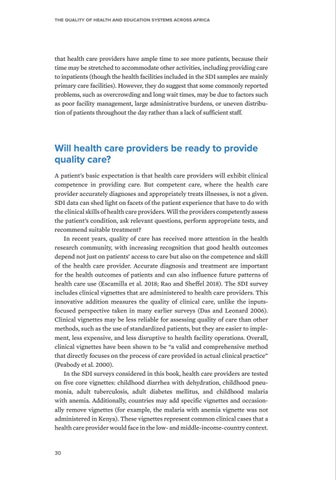The Quality of Health and Education Systems Across Africa
that health care providers have ample time to see more patients, because their time may be stretched to accommodate other activities, including providing care to inpatients (though the health facilities included in the SDI samples are mainly primary care facilities). However, they do suggest that some commonly reported problems, such as overcrowding and long wait times, may be due to factors such as poor facility management, large administrative burdens, or uneven distribution of patients throughout the day rather than a lack of sufficient staff.
Will health care providers be ready to provide quality care? A patient’s basic expectation is that health care providers will exhibit c linical competence in providing care. But competent care, where the health care provider accurately diagnoses and appropriately treats illnesses, is not a given. SDI data can shed light on facets of the patient experience that have to do with the clinical skills of health care providers. Will the providers competently assess the patient’s condition, ask relevant questions, perform appropriate tests, and recommend suitable treatment? In recent years, quality of care has received more attention in the health research community, with increasing recognition that good health outcomes depend not just on patients’ access to care but also on the competence and skill of the health care provider. Accurate diagnosis and treatment are important for the health outcomes of patients and can also influence future patterns of health care use (Escamilla et al. 2018; Rao and Sheffel 2018). The SDI survey includes clinical vignettes that are administered to health care providers. This innovative addition measures the quality of clinical care, unlike the inputs- focused perspective taken in many earlier surveys (Das and Leonard 2006). Clinical vignettes may be less reliable for assessing quality of care than other methods, such as the use of standardized patients, but they are easier to implement, less expensive, and less disruptive to health facility operations. Overall, clinical vignettes have been shown to be “a valid and comprehensive method that directly focuses on the process of care provided in actual clinical practice” (Peabody et al. 2000). In the SDI surveys considered in this book, health care providers are tested on five core vignettes: childhood diarrhea with dehydration, childhood pneumonia, adult tuberculosis, adult diabetes mellitus, and childhood malaria with anemia. Additionally, countries may add specific vignettes and occasionally remove vignettes (for example, the malaria with anemia vignette was not administered in Kenya). These vignettes represent common clinical cases that a health care provider would face in the low- and middle-income-country context.
30


